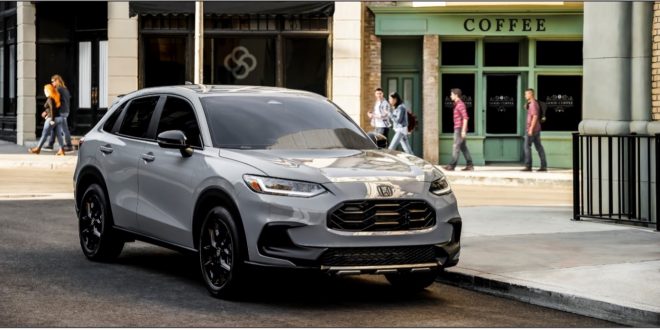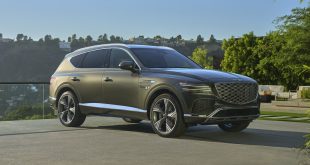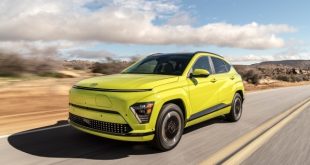Stylish, sporty, and with a roomier feature-rich interior, the all-new 2023 Honda HR-V gains aspirational qualities beyond its segment. Designed and engineered without compromise, the second-generation HR-V is longer, wider, and more fun-to-drive than its predecessor, while featuring improved front and rear interior comfort, and one of the largest cargo areas in its class to enhance the lifestyle of young, active buyers.
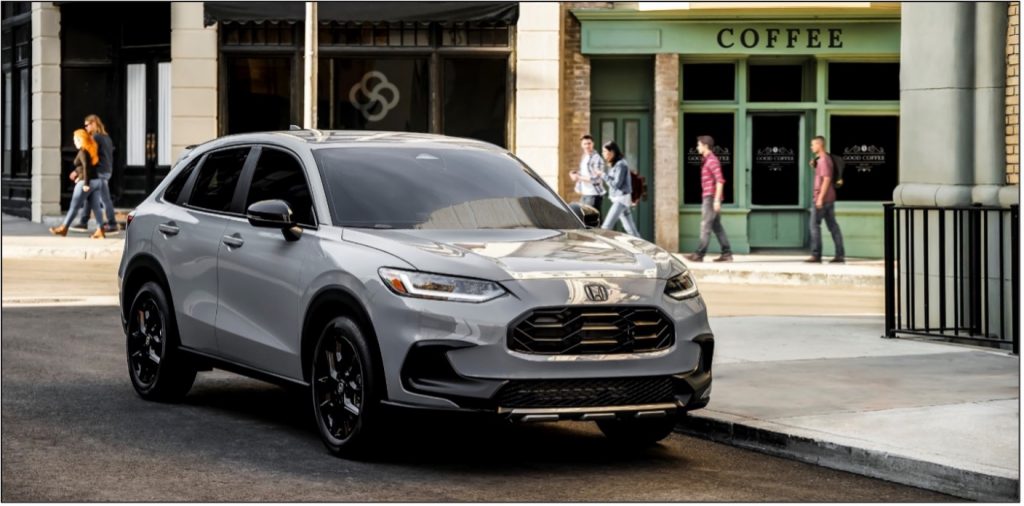
Available in LX, Sport and EX-L grades, the 2023 HR-V’s new exterior design features a sleeker roofline and longer hood creating a sportier and more upscale profile. A low horizontal beltline adds athletic definition to HR-V’s flowing forms. A new larger grille and wide-set headlights and taillights emphasize HR-V’s width, while a sculpted rear hatch and standard tailgate spoiler highlight its sporty proportions.
HR-V’s clean and sporty interior is a fresh take on Honda’s new “simplicity and something” design direction introduced with the 2022 Civic. The wide instrument panel has been designed with minimum cutlines to reduce visual noise and distractions. A striking metal honeycomb mesh conceals the air vents for an uncluttered and harmonious look. Premium materials are used throughout the interior, especially on touchpoints.
Technology also has been smartly integrated into HR-V’s cabin. Standard features include a digital instrument display, a 7-inch touchscreen with Apple CarPlay® and Android Auto™ compatibility, and multiple USB charging ports for driver and passenger. HR-V EX-L features a 9-inch color touchscreen with wireless smartphone integration and additional USB ports.
For a sportier driving experience, the new HR-V is built on Honda’s enhanced global architecture that is also used by the new 11th generation Civic. This new architecture features a new front suspension and new fully independent rear suspension to support improvements in ride, handling and overall refinement. A new dual-pinion electrically assisted power steering system features special tuning to the electronics and a honed steering column for clarity of steering feel.
Powertrain performance and response is improved with a larger 2.0-liter engine with both horsepower and torque increased over the 1.8-liter engine it replaces. A new automatic continuously variable transmission (CVT) is tuned for a more natural response feel and the available Real Time AWD with Intelligent Control System™ has been updated for even better all-weather handling and control.
The second-generation HR-V is a safety performance leader in the crossover segment due to advanced active and passive safety technology that is standard equipment. HR-V features the latest version of Honda’s Advanced Compatibility Engineering™ (ACE™) architecture, specifically designed to meet present and anticipated future collision standards while minimizing additional weight.
Driver and passenger front airbags designed to cradle the head and offer enhanced protection are standard equipment on HR-V, as is the new single-camera Honda Sensing® suite of safety and driver assistive systems.
Exterior Design
Key Exterior, Package and Body Features
- All-new more emotional design is sleek, stylish and sporty
- Sleek roofline and long hood create a sportier, upscale profile
- 8.7-inches longer
- 2.6-inches wider
- Lower cowl and door-mounted mirrors improve visibility
- Larger grille and standard LED headlights
- Wide LED taillights and sculpted hatch
Sleek, Stylish and Sporty Exterior Design
HR-V’s more emotional design features a low horizontal beltline begins with the extended hood and continues over the swell of the rear fenders adding athletic definition to HR-V’s sleek flowing forms and sporty profile. The low cowl improves visibility along with the outside mirrors, which are now mounted on the doors positioned away from the windshield pillars.
Wide-set LED headlights and taillights highlight HR-V’s increased width (+2.6 inches wider) and sporty stance. HR-V’s overall length also has grown by 8.7 inches.
In front, an expressive grille is flanked by air curtain inlets that route air through the bumper and around the front wheels, improving aerodynamic efficiency. For a cleaner upscale look, laser-brazing technology eliminates the need for roof moldings and HR-V’s windshield wipers hide from view under the hood line when not in use.
In the rear, the sculpted hatch and standard tailgate spoiler highlight HR-V’s sporty proportions, and the outer edge of the taillights have been shaped to improve aerodynamics.

Each HR-V grade features distinct design details. HR-V LX is highlighted by a matte-finish on its honeycomb-style grille and the lower section of the front and rear bumpers. Large 17-inch silver-painted alloy wheels wrapped in 215/60R17 all-season tires are standard.
HR-V Sport gets an even more aggressive horizontal-themed grille mesh, a gloss-black rear spoiler, and a chrome exhaust finisher. The lower portion of the rear bumper is painted gunmetal metallic, and the HR-V Sport’s exclusive 18-inch split 5-spoke wheels are finished in gloss Berlina Black with 225/55R18 all-season tires.
For a distinctly upscale character, the HR-V EX-L features a unique gloss-black version of the honeycomb grille, gloss black door pillars and gloss black trim on the front and rear bumpers. EX-L also rides on 17-inch alloy wheels painted Shark Gray with an exclusive machined finish and wrapped in 215/60R17 all-season tires.
Eight Eye-Catching Colors
HR-V will be available in seven different colors, including the all-new Nordic Frost Pearl, and Urban Gray Pearl. Also available is Platinum White Pearl, Lunar Silver Metallic, Modern Steel Metallic, Crystal Black Pearl and Milano Red.

Interior Design and Package
Key Interior Design and Packaging Features
- Simple, sporty and comfortable cabin is a fresh take on the “simplicity and something” design direction introduced with the 2022 Civic
- Improved passenger comfort
- Exceptional outward visibility
- Simplified dashboard surfaces reduce distractions and reflections
- High-quality switchgear throughout for a class-above experience
- Front Body Stabilizing Seats reduce fatigue
More Comfortable and Premium Cabin
HR-V’s clean and sporty interior is more comfortable, quieter and more premium than before.HR-V is also notably quieter inside than its predecessor, with new sound absorbing inner fenders, sound absorption carpet and an acoustic windshield.
The cabin is a fresh take on the “simplicity and something” design direction introduced with the 2022 Civic. Outward visibility is substantially improved thanks to HR-V’s low cowl, expansive greenhouse and outside mirrors that have been positioned away from the windshield pillars. Further improving visibility is the top of HR-V’s wide instrument panel, which has been designed with minimum cutlines to reduce windshield reflections, visual noise and distractions.
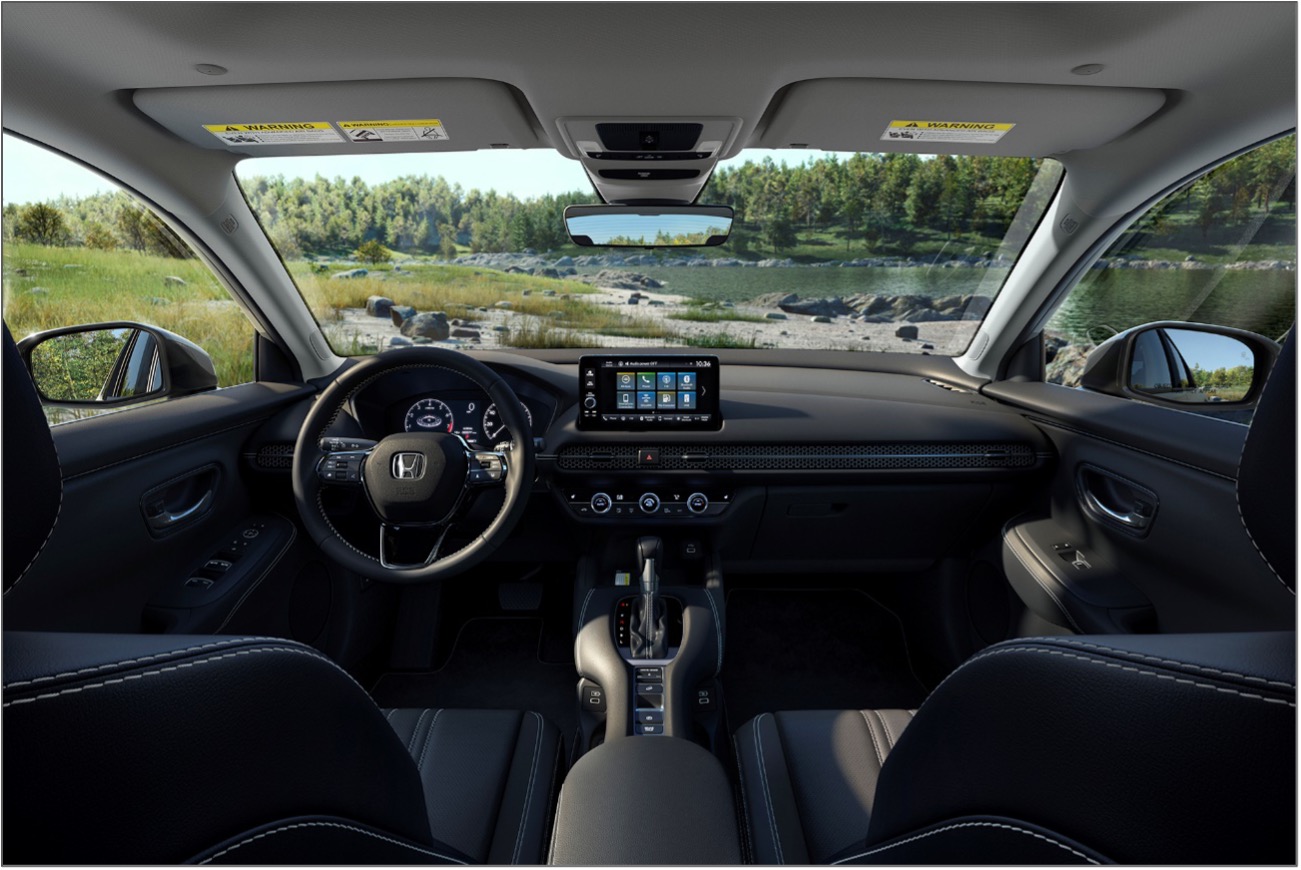
A striking metal honeycomb mesh accent stretches across the dash. It serves both form and function, creating a dramatic visual dividing line between the audio, information displays and the climate controls, while the intricate flow-through design conceals the air vents that would otherwise mar the uncluttered and harmonious look of the dash. The climate control system also benefits from the larger vents, producing 20% better cooling and 30% better heating efficiency.
HR-V’s high-deck center console is uniquely curved and richly upholstered with French stitching for an upscale look. A clever pass-through complete with USB charging ports is ideal storage for small items such as a smartphone.
Premium materials are used throughout the interior, especially on touchpoints, with close attention paid to the operation of all switchgear and controls including the click and heft of knobs, stalks and switches. A metallic finish on components such as the climate control knobs conveying an upscale feel and the turn signal and windshield wiper stalks have been reshaped to be easier to see through the steering wheel. The lower door panels and side panels of the cargo area have been designed with an attractive wavy pattern that better hides scratches and scuffs.
Interior useability is also greatly improved, with lighted USB ports that are easy to find at night, and switches and other controls laid out along the driver’s natural operational flow. HR-V also features new touch-sensitive reading lights for the driver and front passenger, as well as touch-sensitive ceiling-mounted map lights for the rear passengers.
Body Stabilizing Seats Add Comfort and Support
All-new Body Stabilizing Seats firmly hold the body, reducing fatigue and enhancing comfort on long drives. This new front seat design uses multiple internal structures to provide improved support across the entire body, enhancing comfort on long drives. This includes a resin mat that supports the area from the pelvis to the lumbar spine for a more stable and solid seating feel.
An inner frame on the seat bottom stabilizes the hips to reduce movement and posture changes during the various G forces the user may experience while driving. The curve of the seat bottom also leaves no gap between the seat and thighs to mitigate sliding forward, while coupling with the internal structure to reduce forward and lateral pelvic tilt that can lead to fatigue and discomfort on long drives. The seat also centers the upper body over the pelvis, helping to stabilize the upper arms and the eyesight of the driver, making it easier to drive.
Generous Storage and Cargo Space
The stylish new HR-V interior is also a masterclass in large and small item storage. In the passenger cabin, the front center tray ahead of the shifter is ideally sized for even large smartphones, and on EX-L grades it serves as a Qi-compatible charging pad.
The door pockets, glovebox, and center console also are generously sized. The door pockets can easily store large bottles, and the center console has enough space for a tablet or large map book. A handy shelf at the back of the center console is large enough for a smartphone.
Behind the rear seats, HR-V features one of the largest cargo areas in its class. The low 27-inch lift over height makes it easy to load large, heavy items. The longer cargo area and standard 60/40 rear seatbacks, which fold flat quickly, make it easier to haul longer items.
Class-Above Materials and Design
Each HR-V grade has a unique interior treatment. HR-V LX offers seats covered in black or gray cloth with an embossed pattern and mélange fabric insert. The seat color also is repeated on the door armrests, and on the center console. Piano black accents surround the black honeycomb mesh on the dash.
HR-V Sport features similar black cloth upholstery, but with eye-catching bright orange stitching, which is repeated on the dash, doors and center console. The honeycomb mesh features a metallic finish for additional sporty flair.
The front seats of the HR-V EX-L feature additional shoulder support and are available in black or gray leather with a quilted pattern and perforated seating surfaces. Contrast stitching is used on the seats, door panels, dash, and center console. The black honeycomb mesh features an upscale silver accent.
HMI and Technology
Key HMI and Technology Features
- Standard 7-inch color digital instrument display with user-selectable functions
- Standard 7-inch color touchscreen with Apple CarPlay® and Android Auto™ compatibility
- New HD 9-inch color touchscreen with wireless Apple CarPlay® and Android Auto™ compatibility (EX-L)
- Qi-compatible wireless charging (EX-L)
Standard Digital Instrumentation
Technology has also been smartly integrated into the HR-V’s cabin. Every 2023 HR-V features instrumentation with a new 7-inch color TFT display. The digital tachometer and numerical speedometer occupy the left and center, with a physical speedometer on the right.
A section within the tachometer can be toggled through a range of informational screens to present trip computer, audio, phone, compass direction, driver attention monitor, traffic sign recognition and safety support. In between the tachometer and the physical speedometer, the TFT features a Multi Information zone that can present a range of alerts and information, such as Honda Sensing® function selection.
Improved 7-inch Touchscreen & Audio System
HR-V LX and Sport models feature a new audio system with a 7-inch color touchscreen. Functionality is improved by a new physical power/volume knob on the left side, as well as a tuning/selection knob on the right side. At the bottom is a row of hard buttons for many functions including skipping music tracks, navigating the audio menu and selecting between phone, radio, Bluetooth® or USB media.
The physical buttons on the audio system are large and easy to use, and the system uses a fast processor for quick response with virtually no lag after inputs. To make it easier to use the switches and touchscreen when the vehicle is in motion, the screen is recessed slightly from the edge of the dash, resulting in a 0.8-inch finger rest that allows the user to steady their hand while making selections.
Apple CarPlay® and Android Auto™ compatibility is standard, connected through the 2.5A USB-A port near the tray in front of the gear selector. Two additional USB-A charging ports are in the passthrough under the center console. On LX trims, the audio system powers four speakers, one in each door, while Sport adds a tweeter to each A-pillar.
New 9-inch Touchscreen & Audio System
HR-V EX-L features a 9-inch color touchscreen and audio system designed to be very easy to use. This system features a volume knob, physical buttons for Home and Back functions, and large and easy-to-recognize icons. It’s powered by a faster processor for virtually lag-free performance, and a simplified navigation structure with fewer embedded menus.
The 9-inch system also comes standard with wireless Apple CarPlay® and Android Auto™ compatibility, along with Qi-compatible wireless charging. Like the standard 7-inch system, the 9-inch audio features a finger rest to make it easy to use the touchscreen while the vehicle is in motion. The 9-inch system also includes two additional USB-A charging ports at the rear of the center console for easy reach by rear seat passengers.
Designed with simplicity in mind, the 9-inch system features user-defined shortcuts at the bottom of the screen, with HR-V offering six easily programmable shortcuts. Making phone calls with a Bluetooth® connected phone is easier through both a reduced number of layers and screen layout. The 9-inch system also features Wi-Fi hotspot capability, activated through a subscription.
It also uses Smart Shortcuts, an automatic assistant function that enables the user to execute frequently used actions quicker and with fewer steps. The system uses machine learning to predict and propose user preferences based on the track record of the user’s actions and behaviors.
By pressing the icon on the home screen, the system displays frequently used commands, such as the “home” address, frequently visited places, a list of favorite radio programs, redials for received calls, or calling a person on the “favorite” list. For example, with one action, the system can call up the names of people the user calls frequently, eliminating the need to use a directory. These shortcuts are stored on the Smart Shortcut menu, and a unique profile is created for each respective user.
Powertrain
Key Powertrain Features
- Larger and more powerful 2.0-liter 4-cylinder engine
- Updated continuously variable transmission (CVT) improves response and efficiency
- New Step Shift programming simulates gear changes under acceleration
- Improved available Real Time AWD features enhanced traction management on snow
- Honda-first Hill Descent Control is standard
- Econ, Snow, Normal drive modes for custom driving experience
Larger, More Powerful Engine
Powering all HR-V grades is a new, larger 2.0-liter 4-cylinder engine producing 158-horsepower (SAE net at 6,500 rpm) and 138 lb.-ft. of torque (SAE net at 4,200 rpm). The new engine represents increases of 17 hp and 11 lb.-ft. of torque compared to the outgoing HR-V.
A new catalytic converter reduces emissions to the SULEV30 federal standard while using a minimum of rare metals. HR-V’s first Idle Stop system aids fuel efficiency.
To help minimize noise and vibration, HR-V’s 2.0-liter inline four has a lightweight die-cast aluminum block with a bedplate main-bearing design that creates a rigid crankcase assembly. Cast-in iron cylinder liners provide long-lasting durability. Thin slits between each adjacent cylinder sleeve help improve engine cooling and knocking.
Each journal on the lightweight heat-forged steel crankshaft is micro-polished to reduce internal friction, helping improve smoothness throughout the rpm range and lower noise levels.
Cylinder Head and i-VTEC® Valvetrain
The HR-V’s standard 2.0-liter 4-cylinder engine has a lightweight DOHC cylinder head that is made of low-pressure cast aluminum alloy. With exhaust passages cast directly into the cylinder head, the need for a traditional separate exhaust manifold is eliminated and the catalytic converter mounts directly to the cylinder head.
A low-friction silent chain drives dual overhead cams which in turn operate four valves per cylinder. The cam drive is maintenance free throughout the life of the engine. To assist cooling and detonation resistance, the cylinder head has a cooling passage placed between each pair of exhaust valves.
Combustion chamber shape and valve angles are optimized to help boost fuel efficiency and power. The included valve angle is 35 degrees, to decrease the surface-to-volume ratio of the combustion chambers and help create a flat, compact combustion chamber that minimizes unburned hydrocarbon emissions. The design yields a compression ratio of 10.8:1, yet the engine still operates on regular unleaded fuel.
A high-tumble intake-port design combines with the combustion chamber and piston crown shape to create a high level of airflow tumble. This helps create a homogenous fuel mixture for fuel efficiency and high airflow for high power output.
The 2.0-liter DOHC 16-valve i-VTEC® engine uses an advanced valve control system to combine high power output with high fuel efficiency and low emissions. The system combines dual Variable Timing Control™ (VTC™), which continuously adjusts the intake and exhaust camshaft phase, with Variable Valve Timing and Lift Electronic Control (VTEC®), which changes valve lift, timing and duration of intake valve opening.
By continuously varying the timing of the intake and exhaust camshafts, VTC™ is key to the “intelligent” portion of the system. This helps increase power while also providing a smoother idle (allowing idle speed to be reduced). The cam timing is varied based on input from sensors that monitor rpm, timing, throttle opening, cam position and exhaust air-fuel ratio. The result is increased fuel efficiency and lower emissions. Under certain conditions, VTC™ can hold the intake valves open longer to allow a reverse airflow of intake air into the intake manifold, further improving efficiency.
Pistons/Connecting Rods
Designed with “cavity-shaped” crowns, the pistons in the 2.0-liter engine help maintain stable combustion and contribute to improved efficiency. To reduce weight, minimize vibration and increase operating efficiency, the lightweight pistons have a carefully optimized skirt design. Ion-plated piston rings help reduce friction for greater operating efficiency. Heavy-duty steel connecting rods with tapered small ends are heat-forged in one piece and then “crack separated” to create lighter and stronger rods with an optimally fitted bearing cap.
| 2023 HR-V EPA Fuel Economy Ratings – City/Hwy/Comb. | |
| Trim | Rating |
| LX (FWD) | 26 / 32 / 28 |
| LX (AWD) | 25 / 30 / 27 |
| Sport (FWD) | 26 / 32 / 28 |
| Sport (AWD) | 25 / 30 / 27 |
| EX-L (FWD) | 26 / 32 / 28 |
| EX-L (AWD) | 25 / 30 / 27 |
- Based on 2023 EPA mileage ratings; Use for comparison purposes only; your mileage will vary depending on how you drive and maintain your vehicle, driving conditions, and other factors
Refined Continuously Variable Transmission
HR-V’s new CVT features multiple refinements to improve drivability, throttle response and aid fuel efficiency. Drivability improvements are accomplished with a new Step-Shift, updated programming for G-Design shift, and updated downshift control strategy.
A new Step-Shift function is activated during acceleration. The CVT is programmed to control engine speeds in “steps,” similar to a traditional automatic transmission, giving drivers a familiar audible cue for a better sense of acceleration.
In various situations from normal to sporty driving, the updated G-Design shift further improves the linearity of the driver’s throttle input relative to the acceleration of the vehicle.
The downshift control adds engine braking when traveling downhill and is redesigned to improve throttle response during spirited driving as well as increased engine braking in highway driving. When the driver presses the brake pedal while cornering or on the highway, the CVT will select an appropriate lower ratio, maintaining a higher engine speed. This creates stronger engine braking while improving the throttle response when acceleration resumes. The higher engine speed continues until the driver resumes a cruise or neutral throttle condition.
To aid fuel efficiency, the CVT uses a new, more robust electric hydraulic pump. In a conventional CVT, a mechanical oil pump is responsible for both the high hydraulic pressure used to sandwich the steel belt by moving the pulley plates, and low hydraulic pressure for lubrication of each component. For the updated CVT, a new large-size electric oil pump is used to supply high hydraulic pressure for transmission operation, reducing the demand of the mechanical pump, and therefore improving fuel efficiency. In addition, the secondary shaft now uses a ball bearing versus a tapered roller bearing.
Enhanced Real Time AWD with Intelligent Control System™
Available Real Time AWD makes the new HR-V ready for almost any weather condition. Updated for improved traction management in snow, the new Real Time AWD system reacts faster and sends more torque to the rear wheels, making HR-V more responsive and capable, especially in slick, snowy conditions.
Real Time AWD in HR-V combines the conventional front-wheel-drive system with a compact transfer case that distributes torque to a propeller shaft running the length of the vehicle to the rear drive assembly. A multi-plate clutch connects the propeller shaft to the rear differential and is operated by an electric motor driving a hydraulic pump.
The Intelligent Control System activates the electric motor to actively apportion power based on road conditions, preemptively minimizing wheel spin before it happens by sending power to the rear wheels. The electric motor activating the hydraulic pump idles when not required, reducing drag within the system.
When starting on snow, the system sends power to the rear wheels right away, minimizing the potential for front wheel spin. The system also detects when HR-V is climbing a hill, sending more torque to the rear wheels in cooperation with the Hill Start Assist feature. Hill Start Assist maintains brake pressure briefly after the brake pedal is released, giving the driver time to accelerate and smoothly resume motion.
New Hill Descent Control – Standard
Increasing HR-V’s capability and debuting for the first time ever in a Honda crossover is Hill Descent Control for more control on steep, slippery declines. With the press of a button on the center console, drivers can select a speed between 2 and 12 mph using the brake or gas pedal. Once the pedal is released, HR-V will maintain the set speed, allowing the driver to concentrate on steering for as long as Hill Descent Control is active. The driver can adjust speed using either the brake or gas pedal. Hill Descent Control will remain active until the system is shut off or the speed exceeds 12 mph.
Three Drive Modes
For the first-time HR-V features driver-selectable drive modes. Using a toggle located on the center console, the driver can choose between three different drive modes to fine-tune the driving experience depending on conditions.
- Normal Mode
Normal mode is set for a balance between fuel efficiency and driving performance. - SNOW mode
Enhancing traction management in slippery conditions, Snow mode softens throttle response and adjusts the transmission and Real Time 4WD to suit low-traction environments. Idle stop is disabled in this mode. - ECON Mode
Designed for fuel efficient driving, ECON mode changes the pedal input/throttle opening ratio to maintain fuel efficiency, even if the driver operates the acceleration pedal relatively aggressively. Additionally, the air conditioning is set to a more efficient cycle, further aiding fuel efficiency.
Body and Chassis
Key Chassis Features
- Enhanced Honda global architecture is also used by the new 11th generation Civic
- New front suspension and new fully independent rear suspension improve ride quality and handling
- 1.7-inch longer wheelbase
- 2.0-inch wider front and 2.5-inch wider rear tracks
- Stiffer body construction for improved driving dynamics
- Lightweight, rigid aluminum front subframe
- Improved steering feel and braking performance
New Enhanced Global Architecture
Based on a unique enhanced version of Honda’s global architecture, HR-V’s new body/chassis supports improvements in ride, handling and overall refinement. The chassis includes the first-ever fully independent suspension for HR-V, with new MacPherson struts in front and a new multilink arrangement in the rear.
For a smoother ride, HR-V’s wheelbase has been extended to 104.5 inches (+1.7 inches), and its front and rear tracks are significantly wider (+2.0 inches in the front and +2.5 inches in the rear), creating an athletic stance and enhancing stability on the road.
New, Improved Body Structure
Significant improvements have been made to HR-V’s body structure which is strategically stiffer while also better able to manage crash energy. The result is improved ride, handling and NVH, with enhanced safety performance.
Hot-stamped steel is used around the door frame and windshield pillars, as well as in the roof structure. To save weight, an aluminum bumper support is used, along with a resin radiator support.
Consistent with construction methods used in other recent all-new Honda vehicles, structural adhesive is used extensively in HR-V’s construction. The adhesive is applied where spot welds are performed, combining the strength of the weld and the broader surface area of the adhesive. This increases the stiffness of the joint, minimizing the need for increased sheet metal thickness or the addition of welded-on reinforcements.
Refined Front Suspension
HR-V uses a new MacPherson strut front suspension mounted to a lightweight aluminum front subframe with an efficient truss and rib structure that provides rigidity and stability.
A tempering process heat treats the lower ball joints on the front suspension to reduce the surface pressure between the ball and resin ball seat. Additional friction-reducing measures include the use of a low-friction seat for the front damper mount bearings and optimizing the axes of the springs and dampers.
New Rear Multi-Link Suspension
Unlike its predecessor, the second-generation HR-V features a fully independent multi-link rear suspension. Mounted on a new rubber-mounted subframe for noise reduction, the new rear suspension helps provide agile handling, both during normal driving and in emergency maneuvers, together with a flat ride. The trailing arms are mounted to the unibody with fluid-filled compliance bushings for exceptional refinement while maintaining precise handling. HR-V also uses aluminum lower control arms to help reduce unsprung and overall weight.
Responsive Steering
HR-V uses a dual-pinion assist electronic power steering (EPS) which features a honed steering column bearing to reduce steering friction and improve steering feel. In addition, the EPS has been tuned to provide excellent feedback and improved straight-line stability. A non-contact torque sensor measures the driver’s steering effort, and an ECU determines how much electric motor assist to add, with the result being a seamless, natural steering feel.
Feedback control also was added to the EPS, enabling more precise control when unwinding the steering to return to a straight line. This results in smooth steering feel with strong resistance to ride disturbances, and excellent straight-line stability for driver peace of mind.
Improved Braking Performance
All HR-Vs are equipped with 4-wheel anti-lock disc brakes with Electronic Brake Distribution (EBD) and Brake Assist. The system provides a comfortable and refined feel at low speeds, predictable and easy operation on the highway, a sporty, fun-to-drive feel on winding roads, and reassuring high-performance stopping in emergency situations.
Large 12.3-inch diameter ventilated front brake rotors and 12.2-inch diameter rear solid rotors are standard. HR-V also uses a low-friction front caliper with a roll back spring to further reduce brake drag, contributing to fuel efficiency while still maintaining the excellent braking performance.
Safety and Driver Assistive Technology
Key Safety and Driver Assistive Features
- Next-generation Advanced Compatibility Engineering™ (ACE™) body structure optimized for oblique collisions
- Segment-first driver and front passenger airbag designs are engineered to cradle the head and control rotation
- New standard front knee airbags
- New standard outboard rear seat side impact airbags
- All-new standard wide-view, single-camera Honda Sensing® system
- Traffic Jam Assist (TJA) added to Honda Sensing®
- Traffic Sign Recognition (TSR) added to Honda Sensing®
- Updated Adaptive Cruise Control (ACC) and Lane Keeping Assist System (LKAS)
- New blind spot information system (BSI)
- Improved pedestrian protection
ACE™ Body Structure
Designed to meet present and anticipated future collision standards while minimizing additional weight, HR-V features the newest version of Honda’s Advanced Compatibility Engineering™ (ACE™) body structure. Introduced nearly two decades ago, ACE™ is designed to protect vehicle occupants and improve crash compatibility between vehicles of varying sizes, such as an SUV and a small car, and has been continuously advanced.
This latest version of the ACE™ structure in the new HR-V features a new structure that incorporates key new features introduced on the 11th-generation Civic. This includes a robust upper member constructed of high-strength steel, and A-pillar structure, side frame and lower firewall structure all designed to route crash energy around the cabin, especially in oblique impacts.
Additionally, side impact protection has been enhanced with the use of hot-stamp steel in the door ring and B-pillar, along with frame members in the floor and roof that route crash energy around the cabin. The body also is designed to route energy into the roof and floor in the case of a rear collision.
Advanced Airbag and Seatbelt Technologies
HR-V uses new Honda front driver and passenger airbags first introduced in the 11th-generation Civic. These new-design airbags are specifically designed to reduce head rotation in a collision, especially an oblique collision. On the driver’s side, the airbag uses an innovative donut-shaped structure to cradle and hold the head, mitigating rotation and reducing the likelihood of brain injury.
On the passenger side, a three-chamber airbag design achieves a similar result. The three chambers inflate separately, with the two outer chambers that extend above the main chamber designed to cradle the head and control rotation.
HR-V further benefits from additional standard airbag technology, with a total of 10 airbags. Driver and front passenger knee airbags and outboard rear seat side impact airbags are used in HR-V for the first time, along with side curtain airbags and side impact airbags for both driver and front passenger.
Seatbelt technology has been updated as well, with an outer lap belt pretensioner used on front seatbelts, with a load limiter used on the driver’s side to help prevent chest injuries. In the rear, pretensioners are used in both outboard positions, along with load limiters, and HR-V now features a rear seatbelt reminder, which informs the driver if a rear seat occupant is not properly buckled up.
Improved Honda Sensing®
HR-V’s standard Honda Sensing® suite of driver assistive and safety technologies is thoroughly reengineered, and now uses a single camera mounted behind the windshield, coupled with an exceptionally fast processor.
First introduced on the 11th-generation Civic, the new single-camera system features a 100-degree field of view, twice as wide as the camera-and-radar setup of the previous system. The camera detects feature points of a target and recognizes attributes of objects such as vehicles or pedestrians. With the use of the faster processor, the system measures distance and the lateral position of objects based on the change in the size of the target object, how long it took for the change to occur and speed of the vehicle. This enables the camera to recognize white lines, road boundaries such as curbs, other vehicles, pedestrians, bicyclists and road signs.
In foul weather, the system parameters have been changed so it will operate even when the windshield wiper is on at mid or high speeds, as long as the camera can detect objects. In addition, a heater was installed to prevent fogging of the windshield in front of the camera in cold weather. The system software has also been programmed to continue providing assistance in foggy weather.
Honda Sensing® functions include:
- New: Traffic Jam Assist (TJA): works in conjunction with ACC and LKAS to provide lane-keeping functions at speeds below 45 mph all the way to a standstill, such as in congested traffic.
- New: Traffic Sign Recognition (TSR): new camera automatically recognizes traffic speed limit signs, displaying the information on the digital meter immediately after the sign is passed.
- Collision Mitigation Braking System™ (CMBS™): new camera system and more advanced software enables the use of CMBS™ in more situations, including the detection of pedestrians and bicyclists. If no corrective action is taken when FCW signals an alert, CMBS™ can apply different levels of autonomous braking action to help reduce vehicle speed and eventual collision forces, and therefore to help reduce the severity of a collision.
- Forward Collision Warning (FCW, integrated with CMBS™): when the system determines a collision is possible with a detected vehicle, visual and audible alerts from the FCW system prompt the driver to take corrective actions.
- Adaptive Cruise Control with Low-Speed Follow (ACC): new camera system improves Adaptive Cruise Control with more natural brake feel and quicker reactions to changes in traffic. It also responds more quickly when changing into an open lane from behind a slower car, and when a slower car moves out of the lane ahead.
- Lane Keeping Assist (LKAS): LKAS reduces the need for steering correction movements and driving effort. For the 2023 HR-V, LKAS has been improved with more linear and natural feeling steering assist, better line tracing in corners, and improved resistance to crosswinds.
- Road Departure Mitigation (RDM): identifies solid or dashed painted lane lines, Botts’ dots and cat’s-eye markers to find the edge of the road and uses steering force to keep the vehicle from departing the lane or roadway altogether.
- Lane Departure Warning (LDW): integrated with RDM: operates at speeds from 40 to 90 mph and is designed to alert the driver if the vehicle is leaving a detected lane without the turn signal being activated.
Additional Safety and Driver Assistive Technologies
The second-generation HR-V also features additional driver assistive technologies. Standard on Sport and EX-L grades is a new blind spot information (BSI) system. Using millimeter-wave radar installed on the rear corners of the vehicle, it detects vehicles approaching from the rear, signaling the driver with a visual and audible warning.
EX-L grades feature four sonar sensors installed on the front of the vehicle, and four on the back that significantly improve the detection of non-metallic objects such as glass and external exterior walls that could be missed by the radar of the BSI system. This enables the implementation of Low-Speed Braking Control and front and rear false-start prevention, to reduce the likelihood of low-speed collisions, such as in parking situations.
HR-V also features a Driver Attention Monitor, which continually monitors and assesses driver behavior behind the wheel to help determine if the driver is becoming inattentive. If it detects fatigue, the driver is alerted by a coffee cup icon and a 4-level bar graph on the dash. As the driver’s attention drops, fewer and fewer bars are illuminated, and when it drops to two, the system displays a message inviting the driver to take a break. If the driver continues driving and the graph drops to the lowest level of one bar, a beeper sounds and the steering wheel vibrates, prompting the driver to pay closer attention or take a rest break.
Standard on all HR-V grades is a new Rear Seat Reminder. The system chimes when the car is turned off and notifies drivers to check the rear seating area when exiting the car for children, pets or other precious cargo.
Improved Pedestrian Protection
Honda has been an industry leader in designing its vehicles to mitigate pedestrian injuries should a collision occur. The new HR-V front end features new approaches designed to mitigate pedestrian injuries, including a front bumper design intended to prevent or reduce lower leg fractures, and ligament injuries to the knee.
 Asian Fortune Your source for all things Asian American
Asian Fortune Your source for all things Asian American
